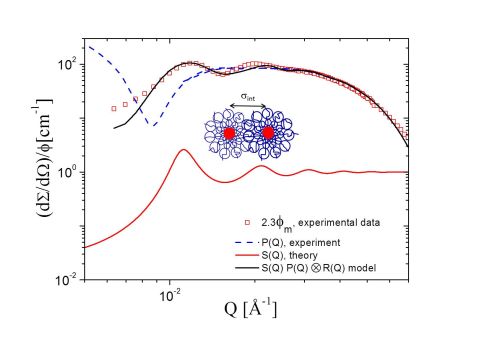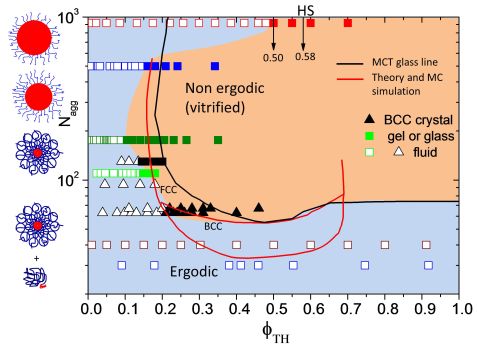MLZ is a cooperation between:
 > Technische Universität München
> Technische Universität München > Helmholtz-Zentrum Hereon
> Helmholtz-Zentrum Hereon
 > Forschungszentrum Jülich
> Forschungszentrum Jülich
MLZ is a member of:
 > LENS
> LENS > ERF-AISBL
> ERF-AISBL
MLZ on social media:

MLZ (eng)
Lichtenbergstr.1
85748 Garching
Dynamic phase diagram of soft nanocolloids – A recipe book
S. Gupta1, M. Camargo2, J. Stellbrink3, J. Allgaier3, A. Radulescu4, P. Lindner5, E. Zaccarelli6, C. N. Likos7, D. Richter3
1 JCNS-SNS, Oak Ridge National Laboratory (ORNL), Bethel Valley Road, Oak Ridge, USA
2 Centro de Investigaciones en Ciencias Básicas y Aplicadas, Universidad Antonio Nariño, Santiago de Cali, Colombia
3 Jülich Centre for Neutron Science (JCNS) at MLZ, Forschungszentrum Jülich GmbH, Garching, Germany
4 Institute Laue-Langevin, Grenoble, France
5 CNR-ISC and Dipartimento di Fisica, Universitá di Roma, Roma, Italy
6 Faculty of Physics, University of Vienna, Vienna, Austria
We introduced new block copolymer micelles, which allows us to investigate a broad range of micellar aggregation numbers 10 ≤ Nagg ≤ 1000 and concentrations 0.1 ≤ ϕ/ϕ* ≤ 10 of soft colloids using the same well-defined model system. We interpret rheological and dynamic light scattering (DLS) data in terms of recently developed experimental and theoretical approaches that quantitatively describe microscopic structures as observed by complementary small angle neutron scattering (SANS) experiments. This finally enabled us to derive the dynamic phase diagram of soft colloids, showing convincing agreement between experiment and theory without any adjustable parameter.
Neither Gaussian chains nor hard spheres
Recent studies on soft matter include a large variety of complex fluids such as synthetic polymers, biological macromolecules, colloids, amphiphilic systems and membranes, as well as liquid crystals. A currently active field of research is focused on the special class of soft colloids, i.e. elastic and deformable colloidal particles, which display a dual character between polymers and hard spheres [1]. Examples of such soft colloids are vesicles, dendrimers, microgels, polymer-grafted nanoparticles, block copolymer micelles and star polymers. Due to their hybrid nature, soft colloids macroscopically show interesting structural and dynamic properties resulting from their unique microscopic structure.
Multi-scale approach combining experiment, theory and simulation

Figure 1: Normalized intensity (dΣ/dΩ)/ϕ for N[~agg~] = 176, ϕ/ϕ* = 2.3 and m:n = 1 : 37, compared to theoretical results, together with contributions from form factor, P(Q), and structure factor S(Q). Inset schematic illustration of overlapping micelles and their interaction length.
We present a comprehensive experimental and theoretical study covering micro-, meso- and macroscopic length and time scales, which enables us to establish a generalized view in terms of the structure–property relationship and equilibrium dynamics of soft colloids. We introduce a new, tunable block copolymer model system, which allows us to vary the aggregation number, and consequently its softness, by changing the solvophobic-to-solvophilic block ratio (m: n) over two orders of magnitude. Based on a simple and general coarse-grained model of the colloidal interaction potential, we verify the significance of the interaction length σint governing both structural and dynamic properties. We put forward a quantitative comparison between theory and experiment without adjustable parameters, covering a broad range of experimental polymer volume fractions and regimes from ultra-soft star-like to hard sphere-like particles, that finally results in the dynamic phase diagram of soft colloids. In particular, we find throughout the concentration domain a strong correlation between mesoscopic diffusion and macroscopic viscosity, irrespective of softness, manifested in data collapse on master curves using the interaction length σint as the only relevant parameter. A clear re-entrance in the glass transition at high aggregation numbers is found, recovering the predicted hard-sphere (HS) value in the hard-sphere- like limit. From the dynamical point of view, it has been verified that both the shear viscosity η0 and the inverse of the self diffusion coefficient DS behave in the same way around the overlap volume fraction ϕ* of the micelles, apparently showing a strong correlation between mesoscopic diffusion and macroscopic viscosity, irrespective of the softness of the colloids.
Neutrons provide basis for rational design of materials
Small angle neutron scattering (SANS) reveals experimental structure factors S(Q) which, in combination with liquid state theory and simulations, lay the basis for understanding soft colloids. As a representative example, in Fig. 1 the partial core contrast SANS I(Q) for m:n = 1:37 and ϕ/ϕ* = 2.3 is illustrated in the open symbols for the forward scattering. The curves for S(Q) calculated for Nagg = 176 and the corresponding ϕTH = 0.162, form factor P(Q) from SANS and P(Q)S(Q) ⊗ R(Q) (resolution) are also displayed.
Dynamic phase diagram as recipe book

Figure 2: Dynamic phase diagram for soft colloids as a function of N[~agg~] and the ϕ. Open symbols: fluid or ergodic phase; solid squares and stars: gel/glass phase (nonergodic); solid triangles: BCC; solid lines: theoretical equilibrium phase diagram, and the MCT ideal glass line; stars: star-polymers from Vlassopoulos et al. Side sketches: schematic representation of micelles and unimers with change in N[~agg~].
All information related to both statics and dynamics has been brought together in an experimental dynamic phase diagram which was compared with the theoretical one, as shown in Fig. 2. Again, packing fraction ϕ based on σint as the only relevant length scale was shown to be the appropriate reduction parameter, allowing a generic description of the macroscopic viscosity η0(ϕ), the mesoscopic diffusivity dynamics D(ϕ) and microscopic structure S(Q), and comparison of these properties for particles with varying softness. The excellent agreement between our new experimental systems with different but already established model systems shows the relevance of block copolymer micelles as a clever realization of soft colloids and the general validity of the coarse-graining approximation for describing structural, dynamical and phase features of dense, soft colloid suspensions, which understanding could provide guidance in the rational design of materials for targeted applications. Finally, this recipe book for soft colloids enabled us to prove the validity of the Stokes-Einstein Relation in soft colloids up to the Glass Transition [3]. Our findings impressively confirm the microscopic origin of colloidal “softness” and its effects on the validity of the Stokes-Einstein relation for degrees of metastability, where it normally breaks down in the case of hard colloidal and molecular systems. In this way, they open up new realms for understanding and tailoring complex fluids, not only with respect to structure and phase behaviour, but also for colloidal dynamics.
References:
[1] D. Vlassopoulos et al., Soft Matter 8, 4010 (2012).
[2] S. Gupta et al., Nanoscale 7, 13924 (2015).
[3] S. Gupta et al., Phys. Rev. Lett. 115, 128302 (2015).
MLZ is a cooperation between:
 > Technische Universität München
> Technische Universität München > Helmholtz-Zentrum Hereon
> Helmholtz-Zentrum Hereon
 > Forschungszentrum Jülich
> Forschungszentrum Jülich
MLZ is a member of:
 > LENS
> LENS > ERF-AISBL
> ERF-AISBL
MLZ on social media:


